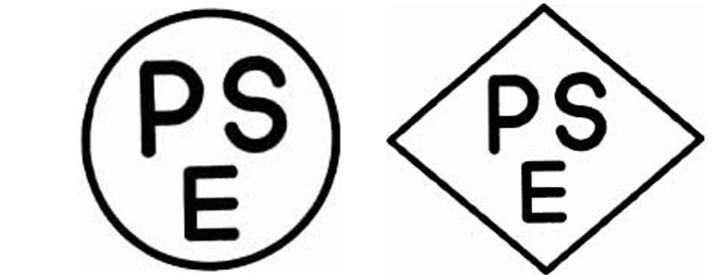PSE certification is a Japanese compulsory safety certification to prove that electrical and electronic products have passed the safety standard test of the Japanese Electrical and Material Safety Law (DENAN Law) or the international IEC standard. Japan’s DENTORL Law (Electrical Device and Material Control Law) stipulates that 498 products must pass safety certification to enter the Japanese market. Among them, 165 types of A products should obtain the diamond-shaped PSE mark, and 333 types of B products should obtain the round PSE mark.
PSE certification mark

Class A: Special electrical equipment and material products Class B: Other electrical equipment and material products
PSE certified product range
The 165 types of A-type products are as follows:
Wires and cables, fuses, wiring appliances (electrical accessories, lighting appliances, etc.), current limiters, transformers, ballasts
Electric heating appliances, electric power application mechanical appliances (household appliances), electronic application mechanical appliances (high frequency epilator)
Other AC electrical machinery appliances (electrical insecticides, DC power supply devices), portable engines
333 kinds of B products are divided into 7 parts:
1. Simple wiring casing and junction box;
2. Simple single-phase motor between 100V-300V;
3. Household electric heating products;
4. Household electric or video game products;
5. Civil or household products that use light sources;
6. Household and commercial electronic products;
7. Other electrical products between 100V-300V.
PSE diamond certification data preparation
1. Application and submission materials: business license, application form;
2. Test preparation materials:
1) CB report (including Japan's difference test);
2) Layout;
3) PCB design drawings related to safety regulations;
4) Specifications of transformers and coil parts;
5) List of key components and their certificates;
6) Japanese user manual or assembly manual;
7) Japanese nameplate and warning signs (including PSE mark and notification of the supplier's name);
8) Structure data table;
9) A list and calibration certificate used in factory production.
3. Provide samples for testing: at least two main inspection models and one for each series model.
Factory inspection
Before issuing the certificate, the inspection agency will conduct a factory inspection on the manufacturer. After the testing and factory inspection meet the requirements, the PSE logo and the logo of the testing agency are allowed to be used on the battery charger.
PSE certification process: (normal mode)
A-type diamond certification process:
Submit application to (Japanese institution or CQC)
↓
Acceptance of quotations, sort out supervision contracts
↓
Authorized laboratory test report
↓
Factory audit (HST counseling, CQC assigns personnel to audit)
↓
Issuing certificates (CQC or Japanese institutions)
↓
Only the first factory inspection is required, there is no follow-up inspection.
Type B circular certification process:
The organization issues an application form for the manufacturer to fill out and submit the application (HST)
↓
Acceptance of quotation and arrangement of supervision contracts (certification and testing contracts)
↓
IEC/ISO17025 laboratory test report
↓
If there is no factory inspection, the PSE certificate will be issued directly after the test result is OK.
PSE diamond certification cycle
4-6 weeks (when the information is complete and the sample does not need to be rectified);
PSE certificate validity period
Type A diamonds have 3 years, 5 years, and 7 years (depending on the specific product)
Type B round has 1, 2 and 3 years (depending on the product)


